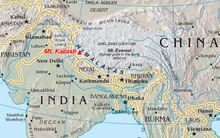


The Indus-Yarlung suture zone or the Indus-Yarlung Tsangpo suture is a tectonic suture in southern Tibet and across the north margin of the Himalayas which resulted from the collision between the Indian Plate and the Eurasian Plate starting about 52 Ma. The north side of the suture zone is the Ladakh Batholith of the Karakoram-Lhasa Block. The rocks of the suture zone consist of an ophiolite mélanges composed of Neotethys oceanic crustal flyschs and ophiolites; the Dras Volcanics: which are basalts, dacites and minor radiolarian cherts – the remains of a mid- to late Mesozoic volcanic island arc; and the Indus Molasse which are an Eocene or later continental clastic sediments.
Some think that the many ophiolites that define the suture are not remnants of a very big ocean, but of a small back-arc basin structure. More recently it has been suggested that these ophiolites formed during Early Cretaceous subduction initiation (Hu and Stern, 2020). You can watch a video about this at https://www.youtube.com/watch?v=02Xojnf9sYA
See also
- Geology of the Himalaya – Origins and structure of the mountain rangePages displaying short descriptions of redirect targets
References
- Age of Initiation of the India-Asia Collision http://geosci.uchicago.edu/~rowley/Rowley/Collision_Age.html
- Dèzes, Pierre, 1999, Major tectonic subdivisions of the Himalaya "Chapter2: Major Tectonic Subdivisions of the Himalaya". Archived from the original on 2010-01-06. Retrieved 2010-02-24.
- Bédard, É.; Hébert, R.; Guilmette, C.; Lesage, G.; Wang, C.S.; Dostal, J. (2009). "Petrology and geochemistry of the Saga and Sangsang ophiolitic massifs, Yarlung Zangbo Suture Zone, Southern Tibet: Evidence for an arc–back-arc origin". Lithos. 113 (1–2): 48–67. Bibcode:2009Litho.113...48B. doi:10.1016/j.lithos.2009.01.011.
Hu, H., and Stern, R. J., 2020. Early Cretaceous Subduction Initiation in Southern Tibet Caused the Northward Flight of India. Geoscience Frontiers 11, 1123-1131.
This tectonics article is a stub. You can help Misplaced Pages by expanding it. |